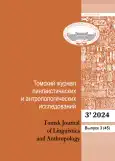Morphological and Lexical-semantic Features of Butterfly Names in the Altai Language
- Authors: Ojnotkinova N.R.1, Erlenbaeva N.V.1, Sarbasheva S.B.1
-
Affiliations:
- Gorno-Altai State University
- Issue: No 3 (2024)
- Pages: 32-44
- Section: LINGUISTICS
- URL: https://bakhtiniada.ru/2307-6119/article/view/270147
- DOI: https://doi.org/10.23951/2307-6119-2024-3-32-44
- ID: 270147
Cite item
Full Text
Abstract
About the authors
Nadezhda Romanovna Ojnotkinova
Gorno-Altai State University
Email: sibfolklore@mail.ru
Gorno-Altaisk, Russia
Nadezhda Viktorovna Erlenbaeva
Gorno-Altai State University
Email: env-1977@yandex.ru
Gorno-Altaisk, Russia
Surna Borisovna Sarbasheva
Gorno-Altai State University
Email: surnasarbasheva@mail.ru
Gorno-Altaisk, Russia
References
- Мухтарова Г. М. Энтомологическая лексика в татарском языке: автореф. дис. … канд. филол. наук. Казань, 2009. 26 с.
- АРС – Алтайско-русский словарь / отв. ред. А. Э. Чумакаев. Горно-Алтайск, 2018. 936 с.
- Алтайско-русский-английский картинный словарь / сост. Н. И. Когунбаева, А. В. Белякова. Горно-Алтайск: Горно-Алтайская типография, 2006. 239 с.
- КРС – Кумандинско-русский словарь: ок. 10 000 слов / сост. Л. М. Тукмачев, М. Б. Петрушова, Е. И. Тукмачева. Бийск: Бийский котельщик, 1995. 150 с.
- РКС – Русско-кумандинский словарь / сост. М. Б. Петрушова, В. М. Данилов, ред. Н. А. Дьайым. Горно-Алтайск: Алтын-Туу, 2021. 504 с.
- РТС – Русско-тубаларский словарь / сост. А. С. Кучукова; ред. С. Б. Сарбашева. Горно-Алтайск: Алтын-Туу, 2019. 384 с.
- СААНТЯ – Словарь алтайского и аладагского наречий тюркского языка / сост. Протоирей В. Вербицкий. Изд-во Православного Миссионерского общества. Казань: Тип. В. М. Ключникова, Большая Проломная улица, 1884; 2-е изд. Горно-Алтайск: Ак-Чечек, 2005. Переизд. 504 с.
- Баскаков Н. А. Северные диалекты алтайского (ойротского) языка: диалект лебединских татар-чалканцев (куукижи): граммат. очерк, тексты, пер., слов / отв. ред. К. М. Мусаев; Ин-т языкознания АН СССР. М.: Наука, 1985. 231 с.
- ТРС – Телеутско-русский словарь / сост. Л. Т. Рюмина-Сыркашева, Н. А. Кучигашева Кемерово: Кемеровское книж. изд-во, 1995. 119 с.
- Каксин А. Д., Чертыкова М. Д. Хакасско-русский и русско-хакасский тематический словарь (разделы «Человек», «Флора и фауна»). Абакан: Изд-во ХГУ, 2020. 224 с.
- ХРС – Хакасско-русский словарь = Хакас-орыссöстік / М-во образования и науки Республики Хакасия, Хакас. науч.-исслед. ин-т языка, литературы и истории; под общ. ред. О. В. Субраковой. Новосибирск: Наука, 2006. 1111 с.
- ТувРС – Тувинско-русский словарь / под ред. Э. Р. Тенишева. М.: Советская энциклопедия, 1968. 646 с.
- МРС – Монгольско-русский словарь / под ред. А. Лувсандэндэва. М.: Гос. изд-во иностр. и национ. словарей, 1957. 715 с.
- ДТС – Наделяев В. М., Насилов Д. М., Тенишев Э. Р., Щербак А. М. Древнетюркский словарь. Л.: Наука, 1969. 676 с.
- ЭСТЯ – Севортян Э. В. Этимологический словарь тюркских языков: Общетюркские и межтюркские основы на букву «Б» / АН СССР. Ин-т языкознания. М.: Наука,1978. 349 с.
- СИГТЯ – Сравнительно-историческая грамматика тюркских языков. Лексика / Э. Р. Тенишев, Г. Ф. Благова, И. Г. Добродомов, А. В. Дыбо, И. В. Кормушин, Л. С. Левитская, О. А. Мудрак, К. М. Мусаев. 2-е изд., доп. М.: Наука, 2001. 822 с.
- АТ, ЧБ-ЧК – Акулова Т. ЧарасБажы – Чöрчöккабайы. Горно-Алтайск: изд-во «Юч-Сюмер», 2003. 376 с.
- АНП – Алтайские народные песни / сост. М. А. Демчинова, Г. Б. Сыченко. Новосибирск, 2023. 947 с. (Памятники фольклора народов Сибири и Дальнего Востока; Т. 35).
- АЗ – Алтайские загадки = Алтай табышкактар / сост. К. Е. Укачина. Горно-Алтайск: Горно-Алт. отд-e Алт. кн. изд-ва, 1981. 176 с.
- Анохин А. В. Материалы по шаманству у алтайцев. Горно-Алтайск: Ак Чечек, 1994. Реп. изд. 152 c.
- Красная книга Республики Алтай (животные, 3-е изд.) / под ред. А. В. Бондаренко. Горно-Алтайск, 2017. 368 с.
- Каабак Л. В., Сочивко А. В. Бабочки мира. М.: Аванта+, 2001. 184 с.
- МА – Мифология алтайцев: этнолингвистический словарь: в 2 т. / Ойноткинова Н. Р. Новосибирск: ИПЦ НГУ, 2022. Т. 1. 512 с.
- Васильева О. В. Номинации мотыльков и бабочек в Псковском областном словаре с историческими данными (выпуски 1–25) // Вестник Оренбургского гос. пед. ун-та. Электронный научный журнал. 2015. № 2 (14). С. 104–112.
- Гура А. В. Символика животных в славянской народной традиции. М.: Индрик, 1997. 912 с.
- Кун Н. А. Легенды и мифы древней Греции. Пособие для учителей. Изд. 5-е. М.: «Просвещение», 1975. 463 с.
Supplementary files






